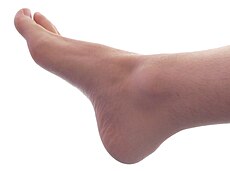This is an old revision of this page, as edited by 12.105.246.2 (talk) at 07:36, 28 November 2010 (→Human foot). The present address (URL) is a permanent link to this revision, which may differ significantly from the current revision.
Revision as of 07:36, 28 November 2010 by 12.105.246.2 (talk) (→Human foot)(diff) ← Previous revision | Latest revision (diff) | Newer revision → (diff) For other uses, see Foot (disambiguation).| It has been suggested that Foot type be merged into this article. (Discuss) Proposed since August 2009. |
The foot is an anatomical structure found in many vertebrates. It is the terminal portion of a limb which bears weight and allows locomotion. In many animals with feet, the foot is a separate organ at the terminal part of the leg made up of one or more segments or bones, generally including claws or nails.
feet often smell of a mushy mixture of tasty liquids of most old people and my grandparents make me rub mainaise on them.
Evolutionary variations
Main article: Comparative foot morphologyA paw is the soft foot of a mammal, generally a quadruped, that has claws or nails. A hard foot is called a hoof.
Depending on style of locomotion, animals can be classified as plantigrade (sole walking), digitigrade (toe walking), or unguligrade (nail walking).
The metatarsals are the bones that make up the main part of the foot in humans, and part of the leg in large animals or paw in smaller animals. The number of metatarsals are directly related to the mode of locomotion —five digits being the most primitive setup, with many larger animals having their digits reduced to two (elk, cow, sheep) or one (horse). The metatarsal bones of feet and paws are tightly grouped compared to, most notably, the human hand where the thumb metacarpal diverges from the rest of the metacarpus.
See also
- Flat feet
- Foot binding
- Foot fetishism
- Foot gymnastics
- Foot washing
- Footsie
- Gait analysis
- Pes cavus
- Sole (foot)
- Runner's toe, repetitive injury seen in runners
- Ball (anatomy)
Footnotes
- France 2008, p 537
References
- France, Diane L. (2008). Human and Nonhuman Bone Identification: A Color Atlas. CRC Press. ISBN 1420062867.
- Marieb, Elaine Nicpon; Hoehn, Katja (2007). Human anatomy & physiology. Pearson Education. ISBN 0321372948.
- Platzer, Werner (2004). Color Atlas of Human Anatomy, Vol. 1: Locomotor System (5th ed.). Thieme. ISBN 3-13-533305-1.
- "Anatomy of the foot and ankle". Podiatry Channel. Retrieved August 2009.
{{cite web}}: Check date values in:|accessdate=(help)
External links
| Human regional anatomy | |||||
|---|---|---|---|---|---|
| Body | Skin | ||||
| Head | |||||
| Neck | |||||
| Torso (Trunk) | |||||
| Limbs |
| ||||
| Muscles of the hip and human leg | |||||||||||||||||
|---|---|---|---|---|---|---|---|---|---|---|---|---|---|---|---|---|---|
| Iliac region | |||||||||||||||||
| Buttocks |
| ||||||||||||||||
| Thigh / compartments |
| ||||||||||||||||
| Leg/ compartments |
| ||||||||||||||||
| Foot |
| ||||||||||||||||
